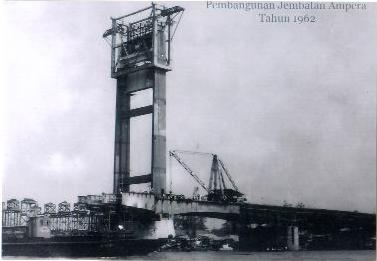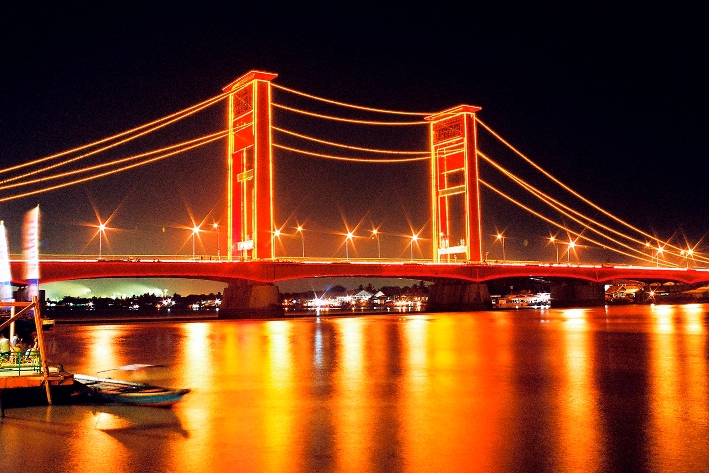 |
| Prasasti Kedukan Bukit (source: sejarah-negara.com) |
Sriwijaya consists of 2 words from Sanskrit. The first word sri means shining and the second word wijaya means victory. Therefore, Sriwijaya means shining victory. And that's not just a name. Sriwijaya continued to gain its victory until the kingdom covered most of South East Asia and became the centre of trading. Sriwijaya attracted traders from Arab, India, and China thus gaining prosperity even more.
Sriwijaya was ruled by 20 kings before facing its downfall. In the 13th century, King Chola from India attacked Sriwijaya causing Sriwijaya to lose its trading centres and routes. This event was made use by a lot of regions to liberate themselves from Sriwijaya. More chaos was ignited everywhere across the kingdom causing Sriwijaya to fall into the hand of The Kingdom of Majapahit at the end.
Palembang was the capital of Sriwijaya during its golden era. After the defeat from King Chola, Palembang became a small unrecognised town. Arya Damar, one of Majapahit warriors, became the mayor of this town. Arya Damar also assisted Majapahit in conquering Bali.
The history during this time has too many versions to explain. Whatever happened after 13th century was a blurry events. Only in the fifteenth century, Palembang was attacked by pirates from China and Admiral Cheng Ho was the one who defeated these pirates. Admiral Cheng Ho also formed Islamic belief to the people of Palembang who was previously under Sriwijaya with its Buddhism and Majapahit with its Hinduism.
Palembang then was under the conquer of The Kingdom of Demak. Some sources said that the founder of Demak was the son of Arya Damar. During this time, Indonesia was mostly influenced by Islam. Only in 1659, Palembang became a kingdom with its own name. The first king was Sri Susuhan Abdurrachman. Palembang continued to be in this state until The Netherlands came to conquer Indonesia and ruled over the kingdom.
 |
| Masjid Agung, a.k.a The Grand Mosque in the 18th Century (Source: iwan-lemabang.wordpress.com) |
War between Palembang and The Netherlands was continuous within the 19th century until the declaration of independence by the first president of Indonesia on 17th August 1945. After that, Palembang became the capital of South Sumatera province. The birth of Palembang was recognised as the date of Dapunta Hyang's expedition, i.e. 17th July 688. With this date declared, Palembang became the oldest city in Indonesia.
Geographically, Palembang is divided by a river in the middle of the city. This river is the well-known Musi River. The southern side of the river is the upstream, called Seberang Ulu and the northern side of the river is the downstream called Seberang Ilir. Ampera River was then built and opened for operation in 1965 to ease the traffic between the two sides of the city. This bridge was designed as vertical lift bridge that can open up when large ship passing by. Sadly, this mechanism only worked until 1970 due to unacceptable 30 minute delay for opening up the bridge, or ban of large ships passing Musi River, or the flaw in the foundation system not allowing the mechanism to continue without risking the safety. Nobody knows the truth. But until today, the red bridge is still there, standing proudly.
 |
| The Construction of Ampera Bridge, 1962 (Source: kokocicipalembang.weebly.com) |
 |
| Ampera during Its Glorious Day of Vertical Lift (Source: kokocicipalembang.weebly.com) |
 |
| Ampera in this Millenial Era (Source: kokocicipalembang.weebly.com) |
I am from Palembang but I have yet to talk about my own city. Here I am, preparing to take a trip as a traveller in this graceful old city. When I was little, nothing was done to enhance the beauty of the city. Palembang was left untouched and wrinkled by itself. Only after former President Susilo Bambang Yudhoyono proposed Palembang to be developed as water tourism city in 2005, things started to be tended and mended. Renovation of Benteng Kuto Besak, a plaza in front of Musi River facing Ampera Bridge, kicked start the effort. After that, Ampera Bridge was repainted and lights were installed along the bridge. Museums and ethnic centres were once again relived. And in 2008, 'Visit Musi' was officially launched together with Sea Games 2008.
And now, I am proudly saying that my hometown has been more well known, not just as 'the city where SilkAir crashed in 1996'.
So, what are you waiting for? Visit Musi, visit Palembang.
Love is in the air,
Little Feet
No comments:
Post a Comment